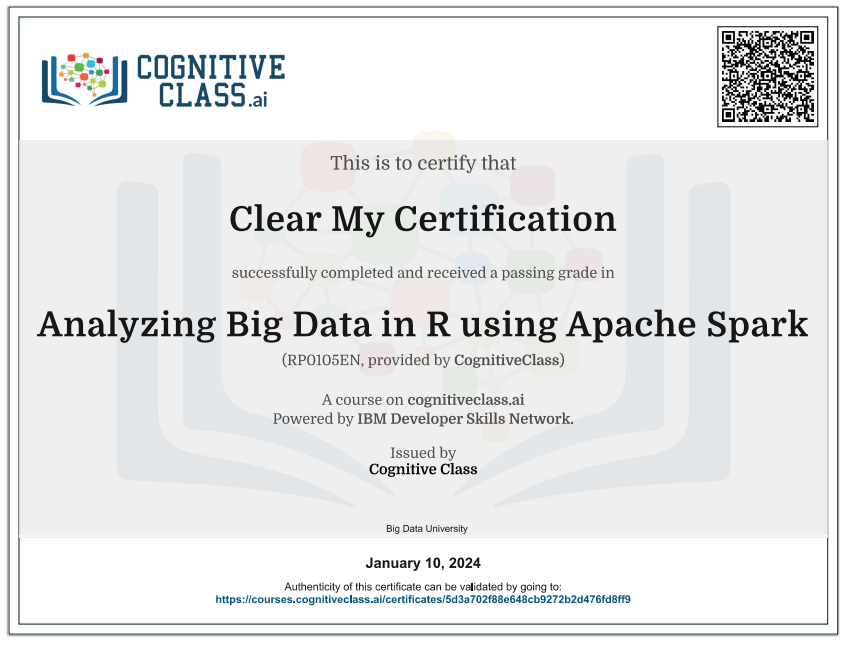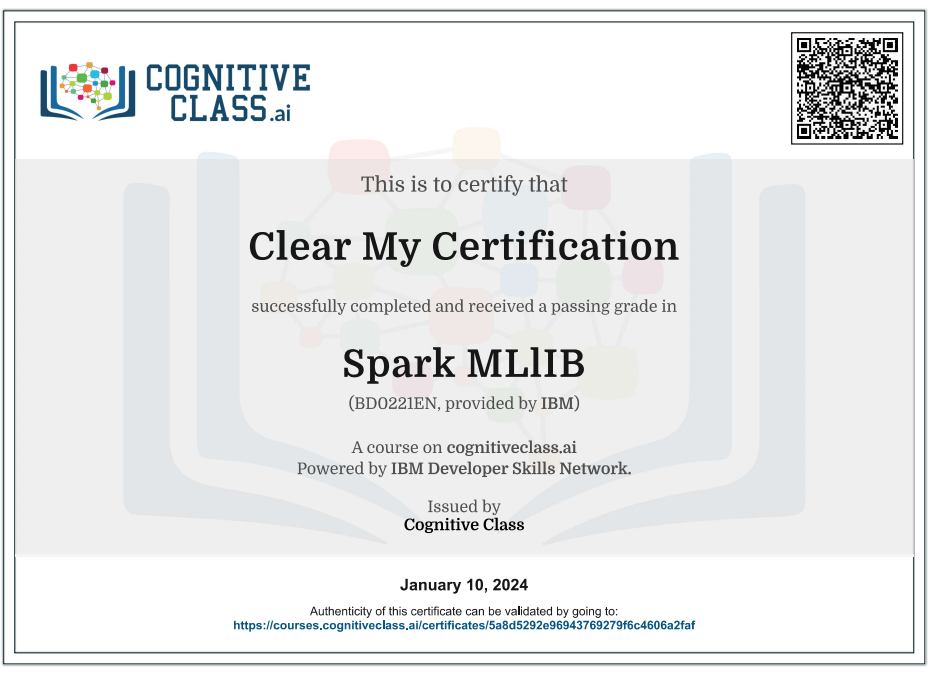Enroll Here: Statistics 101 Cognitive Class Exam Quiz Answers
Statistics 101 Cognitive Class Certification Answers

Module 1 – Welcome to Statistics Quiz Answers – Cognitive Class
Question 1: Which one of the following is not an example of statistics?
- The sweet smell of success
- Monthly housing prices in a city
- Traffic noise at a busy intersection
- Annual unemployment rate in a country
Question 2: Which of the following statements is true? One can estimate the votes for a presidential candidate in a forthcoming election by:
- Asking your barber
- Conducting a poll of a random sample of the voting age population
- Asking your favourite university professor about who is going to win
- Asking the cab drivers in a city of their vote preference
Question 3: Which of the following is not a type of data visualization? (Pick the most appropriate answer)
- An organization chart
- A pie chart
- A time series plot
- A bar chart
Module 2 – Descriptive Statistics Quiz Answers – Cognitive Class
Question 1: Which of the following is not a cross-sectional data set?
- Monthly survey of consumer confidence
- National Census conducted every 5 or 10 years
- Weekly data on average temperature
- A survey of student satisfaction conducted at the end of the course
Question 2: Which of the following is an example of time series data?
- Number of dolphins in the Pacific Ocean
- Average batting average of a baseball player
- Number of trees in Jardin du Luxemburg in Paris
- Annual average housing price in New York
Question 3: Which of the following is an example of multivariate data?
- Vital signs recorded for a new born baby
- Number of songs played in a day by your favourite radio station
- Daily temperature recorded by a monitoring station in Antarctica
- Number of words spoken by President Donald Trump in his inaugural speech
Module 3 – Advanced Descriptive Statistics Quiz Answers – Cognitive Class
Question 1: What is a suitable way to display the average income earned by men and women in a city?
- A scatter plot
- A pie chart
- A histogram
- A bar chart
Question 2: What is a suitable way to display relationship between two continuous variables?
- A scatter plot
- A pie chart
- A histogram
- A bar chart
Question 3: What’s the best way to display median and outliers?
- A bubble chart
- A time series plot
- A box plot
- A scatter plot
Module 4 – Visualization Quiz Answers – Cognitive Class
Question 1: What is the best way to display daily temperature for a city?
- A histogram
- A pie chart
- A Box plot
- A line plot
Question 2: What extra step is needed to display two related time series variables that differ greatly in magnitude?
- Use two axes to display the lines
- Plot them by colouring the lines with different colours
- Plot the lines with different thickness
- Plot them separately in two charts
Question 3: When the sum of two or more categories equals 100, what chart type is ideally suited for displaying data?
- A line chart
- A pie chart
- A box plot
- A histogram
Module 5 – “From Start to Finish: Beauty Pays Data” Quiz Answers – Cognitive Class
Question 1: When using sample data with weights, it is important to compute statistics by:
- Filtering the data with the weight variable
- Weighting the data with the appropriate variable
- Ignoring the weights
- None of the above
Question 2: When multiple observations are reported for each respondent in the data set, to compute statistics for variables about the respondents, one must:
- Ignore the presence of duplicates and compute statistics as usual
- Weight data by duplicates
- Remove duplicates before running analysis
- None of the above
Question 3: To be able to trace one’s steps, one must:
- Generate and record syntax for every command executed for the analysis
- Note steps taken for the analyses in a notebook
- Use mouse for point and click to undertake the analysis
- None of the above
Statistics 101 Final Exam Answers – Cognitive Class
Question 1: What is meta data?
- Data about metal fatigue
- The metabolism data in a clinical trial
- The data about metamorphism
- It’s the data about data
Question 2: Which of the following is not an example of big data?
- Number of photographs uploaded to the internet every day
- The emails sent daily from your email provider
- The number of big basketball players in NBA (National Basketball Association)
- Weekly data about individual credit card transactions registered for your local credit card company
Question 3: SPSS is ideally suited to analyze data stored in:
- Books as words and paragraphs
- Digital video files of Hollywood movies
- Tables as rows and columns
- Digital audio files of music records
Question 4: Reproducibility in statistical analysis requires one to use statistical software that supports:
- Free usage for analysis
- Syntax (script) based analysis
- Tabular output of results
- A point and click environment
Question 5: Which of the following is an example of categorical data?
- Number of fire hydrants in a city
- Number of children at a kindergarten
- Length of the river Nile
- Mode of travel to work
Question 6: Which of the following is not an example of ordinal data?
- Ranking of athletes in an Olympic competition
- Number of trees in a park
- Level of happiness on a scale of 1 to 5
- Street numbers
Question 7: Which of the following is an example of interval data?
- The ethnicity of a person
- “None”, “Some”, “Frequent” – representing the frequency of exercise
- First, second and third rankings in a sports competition
- Weight
Question 8: For a survey of student satisfaction in a course, the population comprises:
- All students enrolled in the course
- All male students registered in the department
- All A+ students enrolled in the course
- All students registered at the university
Question 9: A mean is meaningful for the following type of data
- Audio data
- Ordinal data
- Ratio data
- Categorical data
Question 10: Median represents a value in the data set where:
- Half of the observations are above the median and the other half below it
- Most observations are negative
- Half of the observations are known and the other half not known
- Most observations are positive
Question 11: If the standard deviation of a variable is larger than the mean, the variable depicts:
- Fluidity
- Low variance
- Smoothness
- High variance
Question 12: A histogram is a graphical display of how a variable is
- Observed
- Displayed
- Distributed
- Recorded
Question 13: The following type of computation is suited for categorical data:
- Proportions
- Standard deviations
- Histogram
- Averages
Question 14: The relationship between two categorical variables can be captured by:
- Standard deviation
- A crosstabulation
- A bar chart
- A histogram
Question 15: The probability of getting a 2 by rolling TWO six-sided dice (with sides labeled as 1, 2, 3, 4, 5, 6) is
- 1/36
- 1/18
- 2
- 2/36
Question 16: What is the best way to determine the significance of relationship between two categorical variables?
- A regression model
- A Pearson Correlation test
- A Chi-square test
- A t-test
Question 17: If two continuous variables are positively correlated, their scatter plot will depict:
- A flat line
- A downward sloping curve
- An upward sloping curve
- None of the above
Question 18: What is the best way to determine the significance of relationship between two continuous variables?
- A regression model
- A Pearson Correlation test
- A Chi-square test
- A t-test
Question 19: A good chart should not be missing the following:
- A self-explanatory variable title
- Thick borders
- A dark background colour
- Bright colours
Question 20: What is the best practice to display axes labels?
- Use self-explanatory variables
- Use variable names
- Use bold font to highlight labels
- Don’t use any labels
Introduction to Statistics 101
Statistics is a branch of mathematics that deals with the collection, analysis, interpretation, presentation, and organization of data. It plays a crucial role in various fields such as science, business, economics, social sciences, and more. Here are some key concepts and terms related to statistics:
- Descriptive Statistics:
- Measures of Central Tendency: Mean, Median, Mode
- Measures of Dispersion: Range, Variance, Standard Deviation
- Inferential Statistics:
- Hypothesis Testing: A method for making inferences about a population based on a sample of data.
- Confidence Intervals: A range of values used to estimate the true value of a population parameter.
- Probability:
- Probability Distributions: Describes the likelihood of obtaining different values in a population.
- Random Variables: Variables whose values are determined by chance.
- Regression Analysis:
- Linear Regression: Examines the relationship between two or more variables.
- Multiple Regression: Examines the relationship between multiple independent variables and a dependent variable.
- ANOVA (Analysis of Variance):
- A statistical method used to compare means among different groups.
- Statistical Software:
- Tools like R, Python (with libraries like NumPy, Pandas, and Statsmodels), SAS, SPSS, and others are commonly used for statistical analysis.
- Sampling Techniques:
- Random Sampling, Stratified Sampling, Cluster Sampling, Convenience Sampling, etc.
- Statistical Tests:
- t-test: Compares the means of two groups to determine if there is a significant difference.
- Chi-squared test: Tests the independence of categorical variables.
- ANOVA (Analysis of Variance): Tests the equality of means across multiple groups.
- Bayesian Statistics:
- A statistical paradigm that involves updating probabilities based on new evidence.
- Data Types:
- Qualitative Data: Categorical data without a numerical value.
- Quantitative Data: Numerical data that can be measured and counted.
- Population vs. Sample:
- Population: The entire set of individuals or instances about whom information is desired.
- Sample: A subset of the population used to make inferences about the entire population.
Statistics is a powerful tool for making informed decisions, drawing conclusions from data, and testing hypotheses. It provides a framework for understanding variability and uncertainty in various phenomena.
 Clear My Certification All Certification Exam Answers
Clear My Certification All Certification Exam Answers



